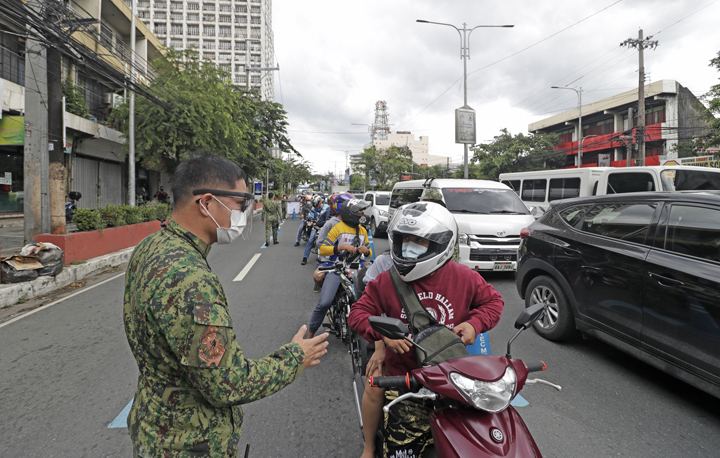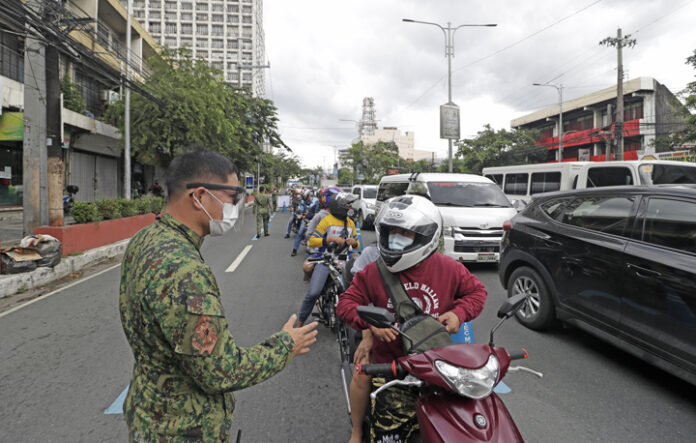
Image credits: Nonie Reyes
IF the trend continues, the National Capital Region (NCR) will record 2,200 cases per day by the end of March 2021, the country is projected to have 665,000 Covid-19 cases and 14,000 deaths by end of this month, OCTA Research Team warned on Wednesday.
“Reproduction number (Rt) of 1.2 should be reduced to lower the projected number of cases and deaths by the end of this month,” Professor Guido David said in a media forum.
Guido said the Rt in NCR is currently estimated to be 1.5 based on a 7-day average, while the Rt in the Philippines is 1.2. The Rt provides the average number of secondary infections by each infected individual.
“The reproduction number in NCR appears to be on an increasing trend, because as infections become more widespread, reversing the spread of the virus becomes more difficult,” he said. Under the current trend, “the number of new Covid-19 cases per day will increase from its current average daily value of 770 to 2,200 by the end of March 2021, unless the spread of the virus is curbed.”
He added that, “The rise in new Covid-19 cases in some local government units (LGUs) in the NCR has become a serious cause for concern.”
Guido said the 4-day average in NCR was 942, while the 7-day average was 762, which is an increase of 61 percent from the previous week and 94 percent from two weeks ago.
“This pattern of increase is similar to the patterns observed in Cebu City, Mountain Province and Benguet, where the SARS-Cov-2 variants were identified. The positivity rate in NCR increased to an average of 6 percent over the past seven days, based on 18,000 PCR tests per day,” he said.
However, hospital bed occupancy in NCR was still low at 36 percent while ICU [intensive care unit] bed occupancy was 52 percent. The two-week daily attack rate in NCR was 4.4 per 100,000.
While Cebu City still had the most number of new Covid-19 cases, averaging 209 per day for the past 7 days, its upward trend has slowed down, as the reproduction number in Cebu City decreased to 1.38.
Where spikes are
In NCR, steep upward trends in new Covid-19 cases were observed in Pasay, Quezon City, Manila, Makati, Malabon, Taguig, Parañaque and Navotas, while Valenzuela, Caloocan and Las Piñas had a smaller increase in new cases.
Guido noted that four LGUs in the NCR have recorded “sharp two-week rise” in new Covid-19 cases from February 24 to March 2: Pasay recorded a 91-percent increase in cases, Quezon City with 58 percent, Makati with 79 percent and Manila with 37 percent.
In Pasay, Makati, Malabon and Navotas, the daily attack rate had exceeded 7 per 100,000, which classifies these LGUs as high-risk areas according to DOH guidelines. Pasay had the highest daily attack rate at 21.75 per 100,000.
Meanwhile, in CAR, the number of new Covid-19 cases in Baguio City, La Trinidad and Tabuk, Kalinga, also had upward trends, while the daily attack rate in these three LGUs were above 7 per 100,000.
Mitigation possible
For his part, Professor Ranjit Rye said that “this potentially serious surge in the NCR is still in its early stages and can still be mitigated.”
While the situation in the region is still manageable, Rye stressed the need to act as one and “we need to act now to prevent the surge from becoming full-blown and potentially overwhelming the health care system in the NCR.”
He said the key is implementing “timely and appropriate responses to reverse the surge. In the high-risk LGUs identified in the NCR and other LGUs around the country, we urge the local government units concerned to further intensify their efforts at testing, tracing, and isolation to reverse the increase in transmissions in their communities.”
Furthermore, he said, in the identified high-risk LGUs, the implementation of more aggressive and effective localized lockdowns with stricter border controls is urgently needed to suppress further viral transmissions.
Both the national government and LGUs “must strictly monitor and enforce compliance with minimum health standards such as physical distancing, the wearing of face mask and face shields and proper hygiene to reverse the increase in transmissions at the community level,” he said.
He underscored the need for the national and local governments to work together to limit the spread of new cases by increasing testing, contact tracing, isolation and quarantine, and the implementation of targeted lockdowns at the community level.
Covid cases
The Covid-19 cases in the country surged to 582,223 after recording 1,783 additional infections.
As of 4 p.m. of March 3, the Department of Health also recorded 330 recoveries and 20 deaths.
Of the total number of cases, 6.0 percent (35,056) are active, 91.9 percent (534,778) have recovered, and 2.13 percent (12,389) have died.
Seven laboratories were not able to submit their data to the Covid-19 Document Repository System on March 2, 2021.
Read full article on BusinessMirror

